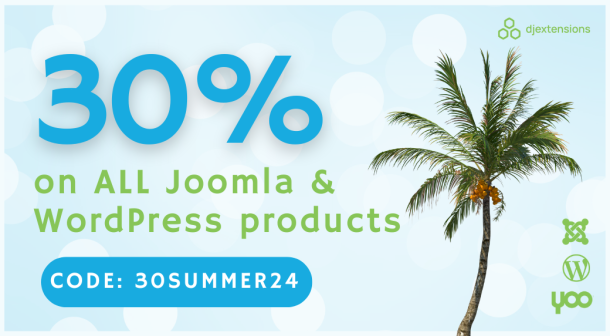
How to Create an eCommerce Website with Joomla in 6 Steps?
Transitioning to online sales of products and services, commonly known as eCommerce, represents a significant advancement for your business. Establishing an online presence allows you to reach a broader consumer base beyond your local market. Creating an online store was a difficult task in the past, but modern eCommerce tools and platforms have greatly simplified the process. To streamline the creation and management of your online shop's content, such as listings and purchase orders, every online store requires a content management system (CMS). With its accessible and open-source format, Joomla has emerged as one of the most popular CMS options for all aspiring online store operators, offering a range of benefits for eCommerce.
Creating websites with Joomla is straightforward from start to finish. However, first-time eCommerce operators may appreciate guidance when building an online store with Joomla. Hence, I created this six-step guide to help you build an eCommerce website with Joomla, making the process straightforward. By following this tutorial, you'll quickly be on your way to developing a robust and flexible online store.

Step #1: Choosing the Best Web Hosting Provider
Before selecting your domain name, finding the ideal web hosting for your website is crucial. This step offers a range of options, including choosing between dedicated, shared, or managed hosting services from different providers. Many hosting companies now cater specifically to the needs of online shop operators, making their services a favorable choice for you.
Step #2: Select a Domain Name
When building an online store, you must start from the ground up. That often means buying the digital "land" upon which the best Joomla web developer will build your online store. To get started, you'll need to register a domain name.
Your domain acts as the front sign for your online store, so it should be unique and memorable. For example, if you have a tea shop named Lena's Tea Shop, consider a simple domain like "lenastea.com" rather than something more complex like "lenasteashoponline.com."
Though tempting, avoid unusual top-level domains like ".pizza" or ".flowers." Statistically, the tried-and-true ".com" and ".net" remain the easiest for customers to remember when navigating to your online store.
Step #3: Downloading and Installing Joomla
With your online presence established, you can download Joomla from its official source. After downloading Joomla, you have two installation options: automatic or manual. Depending on your web hosting provider, you may have access to a one-click installation option in your website control panel. Look for this feature and locate the Joomla button, if available.
If one-click installation isn't available, you'll likely need to install Joomla manually. Begin by accessing your website's main control panel. From there, create a MySQL database where all your website's data, including Joomla software, will be stored. Once the database is set up, upload and implement Joomla on your website. Open a new browser window and navigate to your website's URL to initiate the Joomla installation process. Follow the on-screen instructions to complete the installation successfully.
Step #4: Installing Templates, Plugins, and Add-Ons
Now, you can unleash your creativity and personalize your new online store, tailoring its appearance, layout, and functionality. Joomla offers a diverse selection of templates with unique styles and customization options, enabling you to create a store that perfectly represents your brand. Explore possibilities through your main control panel for additional customization, empowering you to craft a distinctive and captivating online store.
You can check out extensions that offer a wide array of enhancements for your online store, encompassing digital shopping cart management, payment solutions, billing systems, and membership subscription add-ons. Joomla's developers curate an online directory of freely available user-contributed extensions, enhancing your website's functionality and capabilities over time.
However, installing extensions and figuring out the whole eCommerce configuration yourself might be challenging.
Good news for those who find installing extensions and configuring the whole eCommerce system daunting: Joomla offers pre-made eCommerce solutions that include everything an online shop needs, providing a convenient and reassuring option.
For example, DJ-Catalog2 is a powerful eCommerce and directory solution That includes many features needed for a successful eCommerce site: from responsive shopping carts to coupon code generators, basic stock control, automatic invoices, product comparison, tiered pricing, address book, various payment and delivery methods, and much more.
DJ-Catalog2 is a simple-to-setup Joomla extension that provides a modern and responsive output without the need for an advanced configuration.
Step #5: Configure Your Settings
With your online store's primary functionality and appearance in place, you can start configuring the various options to customize it fully. These settings encompass every aspect of your website, including the template, checkout process, SEO, and more. Take your time to read through and apply these initial settings carefully.
Setting up your configuration is an ongoing process, not a one-time task. It requires regular adjustments, especially when adding new product listings. To ensure the effectiveness of your changes, you can conduct live tests of your website using a different browser while logged out as the site administrator.
Step #6: Add Product Listings
Many eagerly await the step of posting product listings. You can use Joomla's built-in functionality to create and manage your listings without much hassle. Joomla intuitively handles much "under-the-hood" information, including pricing and availability.
When visualizing and describing your listings, always remember the power of high-quality product images and rich product descriptions. These elements can greatly influence 'window shoppers' and increase the likelihood of a purchase. Beyond product listings, you can also use this time to flesh out your online store. You should include creating a homepage and essential pages like "About Me" and "Contact Us." Each of these additional pages enhances the atmosphere of your online store and boosts the chances that visitors will remember your store in the future.
Joomla is a Go-to CMS for eCommerce
Joomla makes building and implementing an eCommerce platform as easy as can be. Joomla simplifies eCommerce from back to front, from installation to product listing creations.
Online store websites with Joomla are among the most versatile today, and you can leverage this versatility for your business with just a few clicks.
Now that you've successfully learned how to implement Joomla using this eCommerce website tutorial, you can begin taking the first steps toward making an economic splash online.


